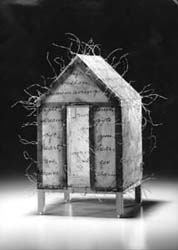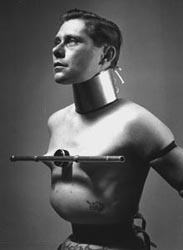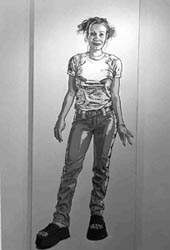Visual Arts Picks
All reviews by Jack Shamama
Making Change: 100 Artists Interpret the Tzedakah Box
Nov 14-Jan 23; Jewish Museum San Francisco, 121 Steuart St; 415.788.9990.
 The Tzedakah box, or Pushke as it's called in Yiddish, is the modest tin box for loose change usually found in Jewish homes and synagogues. The idea of Tzedakah is more complicated, though. It has to do with the obligation to serve and the empowerment of others. The curators of this exhibit asked a wide range of artists from all over the country to address these issues by coming up with a Tzedakah box. The scope of this show is enormous; some of the artists chose to interpret the subject in a playful or campy manner, others in a more serious, heavy-handed way. I was most moved by one "box" by local artist Leah Broder. Hers consisted of an old, weathered physician's bag, etched with the name of her father. The tired old bag sits open, empty, posing questions about how we receive charity from our family and what familial obligations allow us to take for granted. The quiet beauty of the piece outshines many of the flashier pieces of the show. All the pieces are for sale, with the proceeds to go to the Jewish Museum's educational fund, so it's sort of like the show is one giant Tzedakah box itself.
The Tzedakah box, or Pushke as it's called in Yiddish, is the modest tin box for loose change usually found in Jewish homes and synagogues. The idea of Tzedakah is more complicated, though. It has to do with the obligation to serve and the empowerment of others. The curators of this exhibit asked a wide range of artists from all over the country to address these issues by coming up with a Tzedakah box. The scope of this show is enormous; some of the artists chose to interpret the subject in a playful or campy manner, others in a more serious, heavy-handed way. I was most moved by one "box" by local artist Leah Broder. Hers consisted of an old, weathered physician's bag, etched with the name of her father. The tired old bag sits open, empty, posing questions about how we receive charity from our family and what familial obligations allow us to take for granted. The quiet beauty of the piece outshines many of the flashier pieces of the show. All the pieces are for sale, with the proceeds to go to the Jewish Museum's educational fund, so it's sort of like the show is one giant Tzedakah box itself.
Photographs by Fakir
Nov 7-Jan 7; Stormy Leather, 1158 Howard St; 415.626.1672.
 In "On Photography," Susan Sontag tells us, "Photographs provide evidence." Granted, there was no PhotoShop when she wrote this, but there is a certain undeniable truth that you are faced with, even today, when you are standing in front of a framed black-and-white photograph hanging on the wall of a gallery or museum. If Fakir Musafar hadn't meticulously documented his groundbreaking body play, we might never have believed that he ever did what he did. The story goes something like this: He was born in 1930 in South Dakota. When he reached puberty, he became preoccupied with manipulating his body through corsets, piercing, hooks, tattoos and the like. Years later his work would filter down through society and art at large. The photographs themselves are gorgeous. They're black-and-white, which lends itself well to the somewhat antique feel of them. And so these photographs do provide proof that Fakir was doing this, in some cases, way before many of today's art superstars were even born. Ron Athey, Bob Flanagan, Chris Burden and to a certain extent even Matthew Barney and Cindy Sherman--where would they be without Fakir?
In "On Photography," Susan Sontag tells us, "Photographs provide evidence." Granted, there was no PhotoShop when she wrote this, but there is a certain undeniable truth that you are faced with, even today, when you are standing in front of a framed black-and-white photograph hanging on the wall of a gallery or museum. If Fakir Musafar hadn't meticulously documented his groundbreaking body play, we might never have believed that he ever did what he did. The story goes something like this: He was born in 1930 in South Dakota. When he reached puberty, he became preoccupied with manipulating his body through corsets, piercing, hooks, tattoos and the like. Years later his work would filter down through society and art at large. The photographs themselves are gorgeous. They're black-and-white, which lends itself well to the somewhat antique feel of them. And so these photographs do provide proof that Fakir was doing this, in some cases, way before many of today's art superstars were even born. Ron Athey, Bob Flanagan, Chris Burden and to a certain extent even Matthew Barney and Cindy Sherman--where would they be without Fakir?
Caitlin Mitchel-Dayton
Oct 28-Dec 4; John Berggruen Gallery, 228 Grant St; 415.781.4629.
 I am a 25-year-old man. I am reluctantly coming to terms with my adulthood. But if I had my choice in the matter, I'd be a teenage girl. I mean, I read Teen People, and Cosmo Girl. While I have no desire to don a wig and falsies, it just seems like a great time to be a teenage girl in America. I wonder if Caitlin Mitchel-Dayton feels the same way. In her latest series of portraits, she paints teenage girls in all their glory--cute frocks, baggy pants, beat-up stems. The subjects of her paintings have passed through their awkward early adolescence and are moving into young adulthood. They have their whole future ahead of them. Such an exciting time to be a girl! Caitlin's meaty, exuberant brush strokes lend themselves quite well to the subject matter. She paints the human form with as much precision as, say, Philip Pearlstein, but so much more life comes through. In Fifer, the model is sort of pulling up her shirt to show off her paint-splattered pants. Press-ons shows a very beautiful girl in clunky platform sandals and red vinyl pants showing off her new fake nails. Her hair's a mess. She could be a rock star. She could be a supermodel. She could be anything she wants. She's a teenage girl, you know?
I am a 25-year-old man. I am reluctantly coming to terms with my adulthood. But if I had my choice in the matter, I'd be a teenage girl. I mean, I read Teen People, and Cosmo Girl. While I have no desire to don a wig and falsies, it just seems like a great time to be a teenage girl in America. I wonder if Caitlin Mitchel-Dayton feels the same way. In her latest series of portraits, she paints teenage girls in all their glory--cute frocks, baggy pants, beat-up stems. The subjects of her paintings have passed through their awkward early adolescence and are moving into young adulthood. They have their whole future ahead of them. Such an exciting time to be a girl! Caitlin's meaty, exuberant brush strokes lend themselves quite well to the subject matter. She paints the human form with as much precision as, say, Philip Pearlstein, but so much more life comes through. In Fifer, the model is sort of pulling up her shirt to show off her paint-splattered pants. Press-ons shows a very beautiful girl in clunky platform sandals and red vinyl pants showing off her new fake nails. Her hair's a mess. She could be a rock star. She could be a supermodel. She could be anything she wants. She's a teenage girl, you know?
[ San Francisco | MetroActive Central | Archives ]
![[MetroActive Arts]](/arts/gifs/art468.gif)
 The Tzedakah box, or Pushke as it's called in Yiddish, is the modest tin box for loose change usually found in Jewish homes and synagogues. The idea of Tzedakah is more complicated, though. It has to do with the obligation to serve and the empowerment of others. The curators of this exhibit asked a wide range of artists from all over the country to address these issues by coming up with a Tzedakah box. The scope of this show is enormous; some of the artists chose to interpret the subject in a playful or campy manner, others in a more serious, heavy-handed way. I was most moved by one "box" by local artist Leah Broder. Hers consisted of an old, weathered physician's bag, etched with the name of her father. The tired old bag sits open, empty, posing questions about how we receive charity from our family and what familial obligations allow us to take for granted. The quiet beauty of the piece outshines many of the flashier pieces of the show. All the pieces are for sale, with the proceeds to go to the Jewish Museum's educational fund, so it's sort of like the show is one giant Tzedakah box itself.
The Tzedakah box, or Pushke as it's called in Yiddish, is the modest tin box for loose change usually found in Jewish homes and synagogues. The idea of Tzedakah is more complicated, though. It has to do with the obligation to serve and the empowerment of others. The curators of this exhibit asked a wide range of artists from all over the country to address these issues by coming up with a Tzedakah box. The scope of this show is enormous; some of the artists chose to interpret the subject in a playful or campy manner, others in a more serious, heavy-handed way. I was most moved by one "box" by local artist Leah Broder. Hers consisted of an old, weathered physician's bag, etched with the name of her father. The tired old bag sits open, empty, posing questions about how we receive charity from our family and what familial obligations allow us to take for granted. The quiet beauty of the piece outshines many of the flashier pieces of the show. All the pieces are for sale, with the proceeds to go to the Jewish Museum's educational fund, so it's sort of like the show is one giant Tzedakah box itself.
 In "On Photography," Susan Sontag tells us, "Photographs provide evidence." Granted, there was no PhotoShop when she wrote this, but there is a certain undeniable truth that you are faced with, even today, when you are standing in front of a framed black-and-white photograph hanging on the wall of a gallery or museum. If Fakir Musafar hadn't meticulously documented his groundbreaking body play, we might never have believed that he ever did what he did. The story goes something like this: He was born in 1930 in South Dakota. When he reached puberty, he became preoccupied with manipulating his body through corsets, piercing, hooks, tattoos and the like. Years later his work would filter down through society and art at large. The photographs themselves are gorgeous. They're black-and-white, which lends itself well to the somewhat antique feel of them. And so these photographs do provide proof that Fakir was doing this, in some cases, way before many of today's art superstars were even born. Ron Athey, Bob Flanagan, Chris Burden and to a certain extent even Matthew Barney and Cindy Sherman--where would they be without Fakir?
In "On Photography," Susan Sontag tells us, "Photographs provide evidence." Granted, there was no PhotoShop when she wrote this, but there is a certain undeniable truth that you are faced with, even today, when you are standing in front of a framed black-and-white photograph hanging on the wall of a gallery or museum. If Fakir Musafar hadn't meticulously documented his groundbreaking body play, we might never have believed that he ever did what he did. The story goes something like this: He was born in 1930 in South Dakota. When he reached puberty, he became preoccupied with manipulating his body through corsets, piercing, hooks, tattoos and the like. Years later his work would filter down through society and art at large. The photographs themselves are gorgeous. They're black-and-white, which lends itself well to the somewhat antique feel of them. And so these photographs do provide proof that Fakir was doing this, in some cases, way before many of today's art superstars were even born. Ron Athey, Bob Flanagan, Chris Burden and to a certain extent even Matthew Barney and Cindy Sherman--where would they be without Fakir?
 I am a 25-year-old man. I am reluctantly coming to terms with my adulthood. But if I had my choice in the matter, I'd be a teenage girl. I mean, I read Teen People, and Cosmo Girl. While I have no desire to don a wig and falsies, it just seems like a great time to be a teenage girl in America. I wonder if Caitlin Mitchel-Dayton feels the same way. In her latest series of portraits, she paints teenage girls in all their glory--cute frocks, baggy pants, beat-up stems. The subjects of her paintings have passed through their awkward early adolescence and are moving into young adulthood. They have their whole future ahead of them. Such an exciting time to be a girl! Caitlin's meaty, exuberant brush strokes lend themselves quite well to the subject matter. She paints the human form with as much precision as, say, Philip Pearlstein, but so much more life comes through. In Fifer, the model is sort of pulling up her shirt to show off her paint-splattered pants. Press-ons shows a very beautiful girl in clunky platform sandals and red vinyl pants showing off her new fake nails. Her hair's a mess. She could be a rock star. She could be a supermodel. She could be anything she wants. She's a teenage girl, you know?
I am a 25-year-old man. I am reluctantly coming to terms with my adulthood. But if I had my choice in the matter, I'd be a teenage girl. I mean, I read Teen People, and Cosmo Girl. While I have no desire to don a wig and falsies, it just seems like a great time to be a teenage girl in America. I wonder if Caitlin Mitchel-Dayton feels the same way. In her latest series of portraits, she paints teenage girls in all their glory--cute frocks, baggy pants, beat-up stems. The subjects of her paintings have passed through their awkward early adolescence and are moving into young adulthood. They have their whole future ahead of them. Such an exciting time to be a girl! Caitlin's meaty, exuberant brush strokes lend themselves quite well to the subject matter. She paints the human form with as much precision as, say, Philip Pearlstein, but so much more life comes through. In Fifer, the model is sort of pulling up her shirt to show off her paint-splattered pants. Press-ons shows a very beautiful girl in clunky platform sandals and red vinyl pants showing off her new fake nails. Her hair's a mess. She could be a rock star. She could be a supermodel. She could be anything she wants. She's a teenage girl, you know?